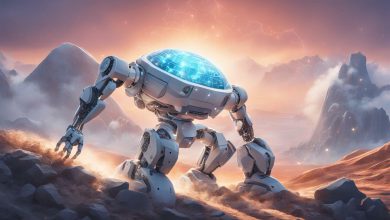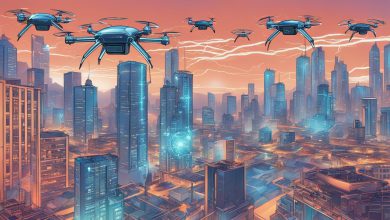
In the world of Artificial Intelligence, two terms that are often used interchangeably are Machine Learning and Deep Learning. While they may seem similar, there are fundamental differences between the two that are important to understand. In this section, we will delve into the core differences between Machine Learning and Deep Learning. We will examine their definitions, applications, and key characteristics.
Key Takeaways:
- Machine Learning and Deep Learning are both subsets of Artificial Intelligence that have distinct differences.
- Machine Learning relies on algorithms to learn from data, while Deep Learning uses neural networks to mimic the human brain.
- Understanding the differences between Machine Learning and Deep Learning is crucial in the development of AI applications.
Understanding Machine Learning
Machine Learning is a subfield of Artificial Intelligence (AI) that involves teaching computers to learn from data, without being explicitly programmed. It is based on algorithms that enable machines to identify patterns and make decisions based on the analysis of large datasets.
There are three primary types of Machine Learning algorithms: supervised learning, unsupervised learning, and reinforced learning. Supervised learning involves providing the algorithm with labeled datasets, so it can learn to classify new data. Unsupervised learning, on the other hand, involves providing the algorithm with unlabeled datasets, so it can identify patterns and relationships in the data. Finally, reinforced learning involves providing the algorithm with a goal or objective, and allowing it to learn through trial and error.
Machine Learning has numerous applications, ranging from image recognition and natural language processing to fraud detection and predictive analytics. It has revolutionized many industries, including healthcare, finance, retail, and e-commerce.
Unveiling Deep Learning
Deep Learning is a subset of Artificial Intelligence (AI) that utilizes Neural Networks – complex algorithms modeled after the human brain – to analyze and learn from data. It is designed to mimic the way humans process and analyze information, making it an incredibly powerful tool for solving complex problems that traditional Machine Learning approaches cannot handle.
The architecture of Deep Learning is more complex than traditional Machine Learning algorithms. It consists of multiple layers of interconnected nodes, each processing and analyzing data at a different level of abstraction, which allows for more accurate and precise results.
Compared to traditional Machine Learning, Deep Learning has several advantages. With its ability to analyze vast amounts of data, it can extract meaningful insights and patterns that would be impossible to detect otherwise. It is also highly adaptable and can automatically adjust and improve its performance over time, making it ideal for rapidly changing and complex environments.
Key Differences between Machine Learning and Deep Learning
Machine Learning (ML) and Deep Learning (DL) are two branches of Artificial Intelligence (AI) that have different approaches to processing and analyzing data. Understanding their differences is crucial in selecting the appropriate technique for a particular problem. Let’s explore the core differences between ML and DL:
Approach
ML focuses on developing algorithms that can learn patterns from data to make predictions or decisions. These algorithms are built using statistical models and require a significant amount of pre-processing of input data.
On the other hand, DL utilizes neural networks to analyze data and develop complex algorithms. It allows for automatic feature extraction and can handle large unstructured datasets.
Data Requirements
ML typically requires structured data that is pre-processed and labeled before training. It is effective when dealing with low-dimensional data.
DL is designed to handle high-dimensional data, such as images, videos, and speech. It requires large amounts of unlabeled data to learn and recognize patterns.
Model Complexity
ML models are usually simpler and easier to interpret. They can be trained quickly with smaller datasets but can be limited in their capabilities.
DL models are complex and can handle more sophisticated tasks such as image and speech recognition. However, they require large amounts of data, computing power, and specialized hardware.
Performance
ML models are suitable for simpler tasks such as linear regression, classification, and clustering. They are faster, more flexible, and require less computing power, making them suitable for real-time applications.
DL models, however, are more accurate and can handle more complex tasks such as natural language processing, object detection, and speech synthesis. They require more computing power and time to train but can achieve state-of-the-art performance in many applications.
Applications of Machine Learning and Deep Learning
Machine Learning and Deep Learning have a wide range of applications in various industries. Let’s take a look at some real-world examples:
1. Healthcare
Machine Learning and Deep Learning are transforming the healthcare industry by improving disease diagnosis, patient outcomes, and drug discovery. They are used in medical image analysis, predicting patient risk, personalized treatment plans, and drug discovery.
For instance, Google DeepMind developed a machine learning algorithm that predicts acute kidney injury up to 48 hours before it occurs, potentially saving lives and reducing patient stays in the hospital.
2. Finance
Machine Learning and Deep Learning are being used in finance for fraud detection, credit scoring, and algorithmic trading. They help to identify fraudulent activities, assess creditworthiness, and automate trading decisions.
For example, JP Morgan Chase developed a machine learning program that analyzes legal documents for faster and more accurate insights during the loan process.
3. Autonomous Vehicles
Machine Learning and Deep Learning are crucial to the development of autonomous vehicles. They enable the vehicles to recognize and respond to complex traffic situations, such as pedestrians and other vehicles on the road.
Companies such as Tesla and Waymo use deep learning algorithms for object detection and path prediction to improve the safety and reliability of their autonomous vehicles.
4. Natural Language Processing
Machine Learning and Deep Learning are used in natural language processing (NLP) to enable computers to process human language and understand meaning. They are used in chatbots, language translation, and sentiment analysis.
For example, Amazon Alexa uses deep learning algorithms to understand and respond to voice commands, making it possible for users to control their smart homes, make purchases, and access information hands-free.
These are just a few examples of the many applications of Machine Learning and Deep Learning. As AI continues to advance, we can expect to see even more industries transformed by these technologies.
Conclusion
In conclusion, understanding the core differences between Machine Learning and Deep Learning is crucial in the ever-evolving field of Artificial Intelligence. Machine Learning is a subset of AI that involves algorithms and statistical models to perform tasks without explicit instructions. On the other hand, Deep Learning uses neural networks to learn and solve complex problems.
While both Machine Learning and Deep Learning have their unique strengths and limitations, it is essential to recognize their differences in approach, data requirements, model complexity, and performance. By doing so, we can determine the most suitable technique for a specific task or problem.
In today’s world, Machine Learning and Deep Learning have numerous real-world applications, ranging from healthcare to finance and autonomous vehicles. As AI continues to advance, the potential for these technologies to transform various industries is significant.
In summary, unraveling the core differences between Machine Learning and Deep Learning is crucial in the field of Artificial Intelligence. By recognizing their unique characteristics, we can ensure that these innovative technologies are used to their full potential, ultimately leading to a more intelligent and automated future.
FAQ
Q: What is the difference between Machine Learning and Deep Learning?
A: Machine Learning and Deep Learning are both subfields of Artificial Intelligence (AI) that involve training algorithms to learn patterns and make predictions. However, the main difference lies in their approach and complexity. Machine Learning uses algorithms to analyze data and make predictions, while Deep Learning relies on neural networks to process and learn from vast amounts of data. Deep Learning is considered more complex and powerful, but it also requires more computational resources and labeled training data.
Q: What are the applications of Machine Learning?
A: Machine Learning has a wide range of applications across various industries. It is used in fields such as healthcare, finance, marketing, recommendation systems, fraud detection, and image recognition. Machine Learning algorithms can analyze large datasets and make predictions or classify data based on patterns and features.
Q: What is the role of neural networks in Deep Learning?
A: Neural networks are the building blocks of Deep Learning. They mimic the structure and functionality of the human brain, allowing Deep Learning algorithms to process and learn from complex data. Neural networks consist of interconnected layers of artificial neurons, with each neuron performing a specific operation on the input data. Through a process called backpropagation, neural networks can adjust their weights and biases to improve accuracy and make more accurate predictions.
Q: How do Machine Learning and Deep Learning differ in terms of data requirements?
A: Machine Learning algorithms typically require labeled training data, where each data point is manually annotated with the desired output. This allows the algorithm to learn patterns and make predictions based on the labeled examples. On the other hand, Deep Learning algorithms can learn directly from raw, unlabeled data. They are capable of automatically extracting features and patterns from the data, making them more adaptable to complex or unstructured datasets.
Q: What are the advantages of Deep Learning over traditional Machine Learning approaches?
A: Deep Learning has several advantages over traditional Machine Learning approaches. Firstly, Deep Learning algorithms can automatically learn and extract features from raw data, eliminating the need for manual feature engineering. This makes them more suitable for complex and unstructured datasets. Secondly, Deep Learning algorithms have the ability to scale and handle large amounts of data, allowing for more accurate predictions. Finally, Deep Learning algorithms can learn hierarchical representations of data, which enable them to grasp complex relationships and achieve state-of-the-art performance in tasks such as image and speech recognition.
Q: What are the real-world applications of Deep Learning?
A: Deep Learning has found numerous applications in various fields. It is widely used in image and speech recognition, natural language processing, autonomous vehicles, recommendation systems, and even healthcare. Deep Learning algorithms have demonstrated exceptional performance in tasks such as medical diagnosis, drug discovery, and genomics, revolutionizing the healthcare industry.







